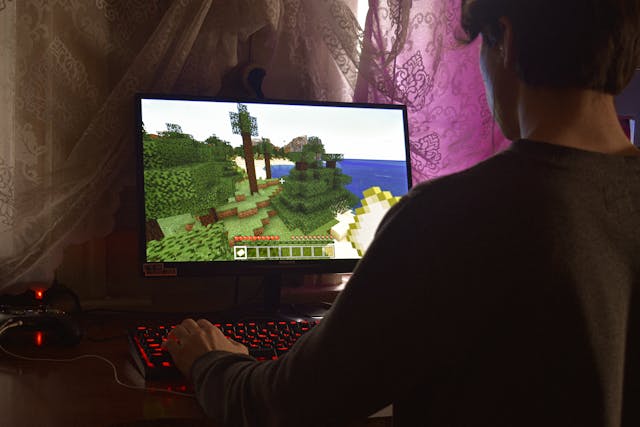Litematica crashing game on server? Discover why it happens, how to fix it, and what really causes those sudden Minecraft crashes.
If Litematica keeps crashing your game on a server, it’s usually due to mismatched mod versions, missing dependencies, or schematic corruption. Fix it by aligning Fabric API, checking configs, and removing damaged schematics.
It always starts innocently.
You load up your Minecraft world, ready to build that massive castle you’ve been planning for days. You open your Litematica menu, load the schematic, and the outlines begin to appear beautifully in the air. Then, just as you rotate your view: freeze.
Your screen locks.
The music cuts.
And seconds later, the game drops you back to the server list with that cold little message:
“Connection lost. Internal Exception: java.lang.NullPointerException.”
It’s not your internet. It’s not your RAM. It’s not even your computer.
It’s Litematica crashing your game on the server: and you’re far from the only one dealing with it.
The frustrating part? It often works perfectly in single-player but refuses to behave the moment you join a server. This isn’t just a reinstall situation. The issue runs deeper: buried in mismatched mod versions, corrupted schematics, and invisible server limits you’re never warned about.
Let’s unpack it layer by layer and fix it for good.
Article Breakdown
What Exactly Is Litematica?
Before we can solve the crashes, it helps to understand what Litematica actually does.
Litematica is a client-side Minecraft mod that lets you view, load, and interact with schematic files: visual blueprints that hover in the air like transparent holograms. It’s primarily used by builders who want to reconstruct large builds block-for-block without missing details.
It works in combination with:
- MALilib (Mattis Library) – a required dependency that provides menus and keybindings.
- Fabric API – a library that ensures the mod communicates properly with Minecraft.
In a single-player environment, everything happens locally. But in multiplayer, Litematica has to communicate with a server environment that might not understand or accept what the client is trying to render.
That’s where problems begin.
Why Litematica Crashes Your Game on a Server
When your game crashes after loading or using Litematica on a server, it’s almost always due to communication failure: the client sending data the server cannot process correctly.
When the Litematica mod version, MALilib, or Fabric API don’t perfectly match the server’s Minecraft version, the mod may attempt to run a function that doesn’t exist or behaves differently in that version. That’s when the crash hits: sometimes instantly, sometimes after minutes of lag or visual glitches.
Let’s go through the most common causes in detail.
Most Common Causes of Litematica Crashes on Servers
1. Mod Version Incompatibility
This is the most common and frustrating cause.
You might have:
- Litematica built for Minecraft 1.20.1
- A server running Minecraft 1.20.4
- MALilib compiled for 1.19.2
On paper, that doesn’t sound too bad: but in modding terms, it’s catastrophic. Even minor version mismatches can break method calls inside the code. The game tries to execute a function that no longer exists or has changed parameters, and it immediately fails.
Fix:
- Match Litematica, MALilib, and Fabric API versions exactly to the server’s Minecraft version.
- Do not rely on “latest” or “compatible” tags: check the exact build numbers.
2. Corrupted or Oversized Schematic Files
Litematica stores blueprints in .litematic files.
If one of these files is corrupted, oversized, or contains broken NBT data, your client can crash instantly when trying to load or render it.
A single malformed block entity inside a schematic can stop the render tick completely.
Fix:
- Test with a smaller schematic first.
- Temporarily remove large or suspicious .litematic files from your schematics folder.
- Recreate the schematic using a clean export.
If smaller schematics load fine, the issue lies with one of the files.
3. Conflicts With Server Plugins
Some servers use plugins that monitor packets sent from clients. Since Litematica sends schematic rendering information, some plugins mistake it for modded gameplay data or unauthorized actions.
Plugins such as anti-cheat or data verification systems might immediately terminate the connection when they detect this unfamiliar data stream.
Fix:
- If you control the server, whitelist Litematica’s client rendering packets.
- If not, contact the server admin and ask whether Litematica or similar mods are blocked. Many building servers allow it under controlled conditions.
4. Missing Dependencies (MALilib or Fabric API)
Litematica won’t run without its required libraries. Missing or outdated versions cause most startup or load-time crashes.
Fix:
- Install MALilib and Fabric API versions that exactly match your Minecraft build.
- Avoid mixing development builds with release versions. Even minor changes in API structure can crash the client during schematic rendering.
5. Outdated Java Runtime
Modern Fabric mods rely on Java 17 or newer. Running outdated Java versions like 8 or 11 can result in instant crashes when Litematica tries to process modern rendering data.
Fix:
Check your Java version with:
java -version
If it’s below 17, install Java 17 or 21 and restart Minecraft using that runtime.
When Litematica Crashes Mid-Build
Sometimes the mod works perfectly until you start placing blocks. Then, halfway through your structure, your game disconnects or freezes.
This usually happens when the schematic extends into unloaded chunks. Litematica attempts to render or interact with areas the server hasn’t fully loaded. When that data isn’t available, it triggers a client crash.
Fix Options:
- Reduce schematic size before loading.
- Disable Easy Place Mode (press M + P, toggle EasyPlace to Off).
- Adjust schematic render range to focus only on nearby chunks.
The smaller your active schematic, the smoother your gameplay will be in multiplayer.
Step-by-Step Troubleshooting Map
A clear, methodical process saves time and frustration. Follow these steps in order:
| Step | What to Check | Tool or Action | Goal |
| 1 | Version Alignment | Check Minecraft, Litematica, MALilib, Fabric API | Ensure perfect version match |
| 2 | Schematic Integrity | Load small test schematic | Detect corruption or oversizing |
| 3 | Dependencies | Verify Fabric API and MALilib | Prevent missing library errors |
| 4 | Render Range | Reduce schematic area | Avoid chunk overreach |
| 5 | Build Modes | Disable Easy Place | Stop permission-based kicks |
| 6 | Java Runtime | Update to 17 or newer | Prevent runtime incompatibility |
By Step 4, most players identify the root cause. If the crash persists beyond Step 6, it’s likely a server-side issue.
Litematica vs Other Schematic Mods
A side-by-side comparison helps understand why Litematica can be more prone to server crashes.
| Feature | Litematica | Schematica (Legacy) | Building Gadgets |
| Active Development | Yes | No | Yes |
| Fabric Support | Yes | No | Yes |
| Multiplayer Stability | Medium | Low | High |
| Large Schematic Handling | Strong | Average | Dynamic |
| Easy Place Mode | Yes | No | Assisted |
Verdict: Litematica remains the most powerful schematic tool available, but it’s also the least forgiving when version mismatches or rendering overloads occur. Its complexity is both its advantage and its weakness.
Preventive Fixes to Keep Litematica Stable
1. Lock Mod Versions
Use a mod manager or launcher that locks mod versions together. Avoid updating one mod without verifying compatibility with others.
2. Limit Render Layers
In the Litematica settings, reduce render layers from 256 to around 32. This lessens the load on your graphics card and RAM, improving server stability.
3. Separate Configs Per Server
Each server can have its own configuration file inside your Minecraft folder. Save unique configs with server-specific names to prevent data overlap.
4. Update GPU Drivers
Graphics driver updates can reduce rendering conflicts that sometimes mimic mod crashes.
5. Avoid Stacking Rendering Mods
Running Litematica alongside shader mods, ReplayMod, or other visual-heavy mods can overwhelm memory. Stick to minimal setups while building large schematics.
When It’s the Server’s Fault
If other players on the same server are experiencing similar Litematica-related crashes, it’s likely a server-side configuration issue. The server may have outdated Fabric libraries, strict anti-cheat filters, or limited network compression settings.
Server Fixes Include:
- Whitelisting Litematica’s rendering packets in plugin or mod configs.
- Updating the Fabric server version to match the clients.
- Increasing the compression threshold in the server configuration to allow larger schematic data transfers.
Once these adjustments are made, most server-side crash cases vanish completely.
FAQ’s
1: Why does Litematica crash only on servers and not in single-player?
Because servers enforce additional data checks and limits that don’t exist in single-player, making client-server desynchronization more likely.
2: What Java version should I use for Litematica?
Use Java 17 or newer. Older versions can’t process modern Fabric mod data structures.
3: Can I use Litematica without MALilib?
No. MALilib is reuired for Litematica’s keybinding and interface systems. Without it, the mod will fail during startup.
4: Why does my game freeze when loading a schematic?
The schematic file may be too large or corrupted. Try smaller files or re-export your schematic to ensure clean data.
5: Are there safer alternatives to Litematica for servers?
Yes, Building Gadgets and Structura are simpler alternatives that offer more stable multiplayer integration.
Key Takings
- The primary cause of Litematica crashing game on server is version mismatch among Litematica, MALilib, Fabric API, and Minecraft.
- Large or corrupted schematics can overload memory and crash the client.
- Disabling Easy Place Mode prevents permission-related disconnections.
- Always use Java 17 or newer for compatibility with modern mods.
- Keep dependencies aligned and regularly updated.
- Maintain separate config files for different servers.
- Crashes affecting multiple players often indicate server-side misconfiguration.



